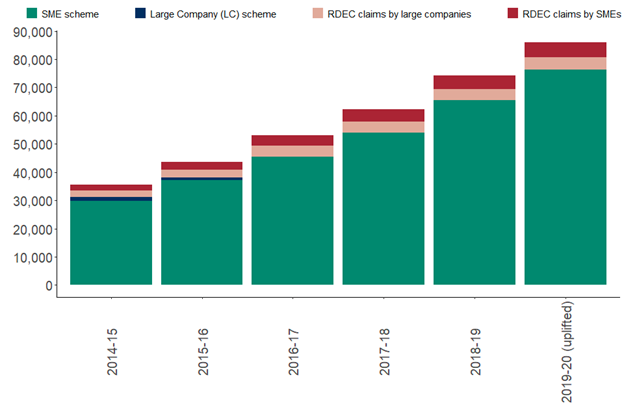With each passing year, more and more businesses are unlocking the power of R&D tax credits.
In fact, both the SME and RDEC schemes experienced growth of 16% and 12% respectively in 2020 alone.

Image source: gov.uk
Yet, as of 2020, the National Centre for Universities and Businesses reported that 56% of businesses had no intention of increasing their R&D and innovation activity. On top of that, they reported nearly a fifth of businesses actually planned a decrease.
This hesitancy to invest in innovation is most likely a response to the unstable business and economic environment of the last couple of years. To counteract this, the UK Government plans to increase public R&D investment to a record high of £20bn by 2024-5.
With all of this in mind, it becomes clear that there is a vital need for more proactive and forward-thinking innovation management.
That’s where innovation governance comes into play.
What is innovation governance?
Innovation governance is the system of mechanisms and processes that align goals, allocate resources and identify decision-making authorities for innovation across your organisation.
By providing a framework to define the parameters of your business’s innovation, innovation governance enables a more comprehensive understanding of a project’s scope.
In turn, this ensures that internal (and, where necessary, third-party) innovation remains a fundamental part of your company’s top-level management practices.
What factors does innovation governance consider?
It’s important to understand that innovation governance considers more than just your company’s research and development.
Instead, it’s intended to manage innovation as a whole throughout your organisation. As such, innovation governance often entails a number of responsibilities:
- Defining key roles and responsibilities within the innovation process
- Defining decision lines within the innovation process
- Establishing the set of values that drive all innovation decisions
- Defining how to measure the success of innovation
- Making decisions based on innovation budgets
- Conducting and prioritising innovation activities across departments and teams
- Establishing management processes around communications and decision making
Why does innovation governance matter to your R&D?
Your organisation is made up of a collection of individuals, each with their unique set of skills and disciplines. To drive these individuals towards the same collective goals, a governance system is fundamental to success.
So, by introducing an innovation governance system within your senior teams, you begin to develop a purpose-driven culture of innovation that encourages business growth.
Why does this matter to your R&D? Well, by promoting a culture of innovation from the top down, you’ll find innovation becomes naturally incorporated into everyday processes and decision-making. This includes opportunities for research and development.
As a result, your team benefits from an enhanced ability to identify and pursue prosperous R&D avenues, leading to bigger and better tax credit claims.
How to implement innovation governance
With the benefits clear, how do you go about integrating innovation governance into your organisation’s DNA?
There are 4 key elements of innovation governance that senior managers and decision makers need to consider. Only by directing and supervising innovation with these pillars in mind can innovation governance be successfully implemented into your company’s processes.
Define your goal
Identifying the purpose of your activity is integral to innovation governance, so define your objectives, priorities and target timeframes from the outset.
Teams should understand and be passionate about the shared vision they’re working towards. So, ensure the vision is specific. What uncertainties are you hoping to overcome? What are the benefits of overcoming them?
Ensure this goal is always measurable with reportable KPIs, too. These should align internal ambitions with the values of stakeholders.
This will not only aid you in tracking your progress, but it’ll also make filing your R&D tax credit claim a little easier (if your activity is eligible, of course!).
Establish your structures
Look to establish specific innovation structures with comprehensive definitions of processes, platforms and unique roles.
Refine and reimagine your innovation cycle with a stringent framework, implementing a clear and efficient approach.
What systems will be in place to assist delivery? What team members will be required and what responsibilities will their roles have? Will external collaboration be required and, if so, how will it be accommodated?
Be sure to consider your communication structures, too. Innovation governance requires everybody to be on the same page, and to be actively invested in the activity being conducted and the reasoning behind it.
So, strive to streamline communication processes between teams, departments, stakeholders and third parties.
Develop your capabilities
Successful innovation governance introduces a defined process for identifying and developing opportunities for innovation.
For example, smaller and less established SMEs are likely to lack the skill, expertise and resource to conduct a full-scale R&D project in-house. In this instance, senior management would be expected to identify the required steps to expand the capacity for innovation.
Of course, they’d also be expected to facilitate this development, sourcing streamlined solutions for innovation hurdles such as outsourcing and infrastructure.
Manage your risks and resources
Optimising your pipeline management is essential to successful innovation governance.
This requires an efficient means of administering and implementing project scopes, goals and timeframes.
As such, there should be clearly defined processes in place for identifying where resources are best allocated. This necessitates a deep understanding of budget management and ROI, so ensure senior staff understand how to source and translate this information.
It also requires your innovation leaders to be competent in performing risk-reward analyses. Developing the ability to balance the associated risk with the potential rewards is a vital element of successful and prosperous innovation management.
Optimising your approach to innovation through purposeful governance will help you bolster efficiencies and spot more opportunities for growth. On top of that, having these structures in place will help your business to manage, measure and optimise your R&D pipeline more effectively.
With improved innovation governance driving R&D success, the next important step is prepping your claims. Need a helping hand? Get in touch with the experts at Lumo today.